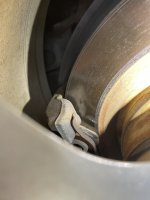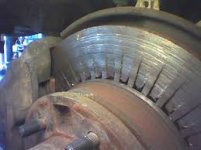You are using an out of date browser. It may not display this or other websites correctly.
You should upgrade or use an alternative browser.
You should upgrade or use an alternative browser.
How much longer should these rear brake pads last?
- Thread starter BMW Dom
- Start date
How could any of us know?
Depends on how aggressively you drive, but from what I can make out in the pic, with normal driving you should easily make it through winter before they *need* replaced, putting on 75mi./week, unless it's a lot of long, mountain descents. Also, we can't see the back pad or the other wheel. If the one pictured is the MOST worn, then the above applies.
3 days. 

Anyway, rear brake usually are not used up as fast as front for obvious reason.
At least that is my experience in Toyotas.
Also, they sell gauge to measure the thickness of brake.
May be invest in those, it is relatively cheap or you can always use a measurement tape if you can put it in between the caliper and brake pad.
Anyway, rear brake usually are not used up as fast as front for obvious reason.
At least that is my experience in Toyotas.
Also, they sell gauge to measure the thickness of brake.
May be invest in those, it is relatively cheap or you can always use a measurement tape if you can put it in between the caliper and brake pad.
Last edited:
Wow.
Passport's picture makes me wonder: do the thinnest metal sections heat / cool into the recessed pockets by bending ?
Or did a pad wear less metal material from nearest the hub compared with more metal wear away from the hub?
I would greatly appreciate sage input .
Passport's picture makes me wonder: do the thinnest metal sections heat / cool into the recessed pockets by bending ?
Or did a pad wear less metal material from nearest the hub compared with more metal wear away from the hub?
I would greatly appreciate sage input .
Yes, replace them, front are still okay.
Fronts look ok. Rears are getting close. The rear pads on my daughter in laws jeep are about the same as these. I’m thinking they might last through the winter but I may replace rotors and pads just to be on the safe side
I put friction replacement on the watch/to-do list when the friction side gets to approximately the same thickness as the metal backing - both pads and shoes.
Modern cars, for quite a while now, apply more pressure to the rear brakes with light braking in order to preserve the the braking of the front wheels for when they are really needed. At least that is what I have been told. They are also made thinner than front brakes. For this reason, the rear brake pads on my Jetta needed to be replaced after only 270,000 miles, while my front brakes are still original. I replaced both pads and rotors.3 days.
Anyway, rear brake usually are not used up as fast as front for obvious reason.
At least that is my experience in Toyotas.
Also, they sell gauge to measure the thickness of brake.
May be invest in those, it is relatively cheap or you can always use a measurement tape if you can put it in between the caliper and brake pad.
MInimum brake lining thickness for PA state inspection for bonded lining is 2/32 of an inch. This is what we replace brake pads at. By eye without measuring id say the fronts are about 9/32 and rears are about 4/32. Now of course without pulling the wheels and calipers for all we know your inboard pads could be metal on metal, slides frozen, etc. On rears id say you have a year left if the inboard pads look like that outboard
The front pad looks like there is about 7-8 mm left? Depending upon your driving style, I would think you have 30k - 40 k life left in them. Perhaps more.
The rear pad looks like about 2 - 2.5 mm? It is ready for replacement. You are safe for now, but as you suggested, I would get it done in the next month or two.
The rear pad looks like about 2 - 2.5 mm? It is ready for replacement. You are safe for now, but as you suggested, I would get it done in the next month or two.
Long time.I’m wondering if I should get these done before the winter. Rear is first, front is after
2009 BMW 328i rwd. About 15 miles 5 days a week. Thanks
View attachment 119229
If you are pushing E90 hard or hard in snow, rear will wear oit much faster due to DTC and E diff. functions.
BMW wear sensors are two stage. Once they trip you still have enough meat for 4-5000 miles. That is yellow brake warning. Second stage, red warning, is when they are at minimum. Even at that point there is 2mm.
So don’t worry!
BMW Dom
Thread starter
- Joined
- Oct 6, 2020
- Messages
- 2,423
According to Bentley, it’s 6mm and 4mm. So anyway, I should have plenty left. I’ll put this on my spring/summer list. Along with front control arms, restore wheels, dye rear window shelf, fix peeling interior plastic, fix cupholders . Bmw thingsLong time.
If you are pushing E90 hard or hard in snow, rear will wear oit much faster due to DTC and E diff. functions.
BMW wear sensors are two stage. Once they trip you still have enough meat for 4-5000 miles. That is yellow brake warning. Second stage, red warning, is when they are at minimum. Even at that point there is 2mm.
So don’t worry!
15 miles a day? You should be fine until after winter, but the rears will need to be done first. I commuted 100 miles a day and had pads that looked like the rear ones last 10,000 miles, and I drive my 328i like it's a rental.
BMW Dom
Thread starter
- Joined
- Oct 6, 2020
- Messages
- 2,423
I rechecked again today, there is much more meat on the rear brake pads than visible in the picture. These will definitely last me through the winter.
I'll be sure to update when I replace them.
Either the Jurid or the TRW ultra will be used
I'll be sure to update when I replace them.
Either the Jurid or the TRW ultra will be used
Based on the pics you provided, I personally would be doing the rears before winter (of course my winter might be colder and longer than yours). If you have a lot more pad left on the inside pad, you might want to make sure that the slides are working free and clear as that's the opposite of what I would expect. You'd "probably" make it through the winter, but who wants to do a brake job in the winter just to get $10 more life out of a set of pads?
FWIW, every BMW I've serviced in the family (E46, E39, E90, F10) has worn out rears first. I would also be looking for coated/painted rotors, or painting the hats myself if needed to keep the rusty uglies at bay.
EDIT: another thing I've noticed on the various floating-piston BMWs - particularly in the rear, in my environment I have found that brake performance falls off well before the pads are actually worn out. But it does so gradually and you don't notice it's missing, but the car nose dives a lot more and simply doesn't stop as quickly when the rear isn't contributing properly. On my E39 everything looked great when inspecting like the pictures you've shown. I noticed however they were measuring something like 5mm for what seemed like forever. When I took them apart I found that the pad was delaminating and the backing plate was flexing in the middle when the brakes were applied. Long story short the rears weren't doing their part to stop the car. Ditto on my F10. Ditto on my SO's Sienna. Now, I probably live in a more corrosive winter environment than most but still.... So, now I don't put rears off for very long. If they're getting close I take them apart or just do them. I inevitably find the vehicle stops much better when complete, and against expectations I find more improvement in stopping performance from a rear brake job than a front brake job (because I'm not running them out until the last possible second). I usually find the smaller, flimsier rear assemblies are failing in structural ways while the beefier fronts don't break down in the same way.
I'm no pro and I only work on family vehicles so my sample size is limited. But this is what I've observed. Don't underestimate how much the rears actually contribute to overall stopping power and keeping the vehicle more level during braking with anti-dive suspension designs which depend on rear brake torque to pull the rear end down while stopping.
FWIW, every BMW I've serviced in the family (E46, E39, E90, F10) has worn out rears first. I would also be looking for coated/painted rotors, or painting the hats myself if needed to keep the rusty uglies at bay.
EDIT: another thing I've noticed on the various floating-piston BMWs - particularly in the rear, in my environment I have found that brake performance falls off well before the pads are actually worn out. But it does so gradually and you don't notice it's missing, but the car nose dives a lot more and simply doesn't stop as quickly when the rear isn't contributing properly. On my E39 everything looked great when inspecting like the pictures you've shown. I noticed however they were measuring something like 5mm for what seemed like forever. When I took them apart I found that the pad was delaminating and the backing plate was flexing in the middle when the brakes were applied. Long story short the rears weren't doing their part to stop the car. Ditto on my F10. Ditto on my SO's Sienna. Now, I probably live in a more corrosive winter environment than most but still.... So, now I don't put rears off for very long. If they're getting close I take them apart or just do them. I inevitably find the vehicle stops much better when complete, and against expectations I find more improvement in stopping performance from a rear brake job than a front brake job (because I'm not running them out until the last possible second). I usually find the smaller, flimsier rear assemblies are failing in structural ways while the beefier fronts don't break down in the same way.
I'm no pro and I only work on family vehicles so my sample size is limited. But this is what I've observed. Don't underestimate how much the rears actually contribute to overall stopping power and keeping the vehicle more level during braking with anti-dive suspension designs which depend on rear brake torque to pull the rear end down while stopping.
Last edited:
Similar threads
- Replies
- 18
- Views
- 731
- Replies
- 7
- Views
- 1K
- Replies
- 76
- Views
- 13K
- Replies
- 15
- Views
- 6K
- Replies
- 20
- Views
- 1K


